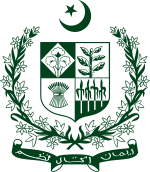Senate (Pakistan)
| National coat of arms | Senate of Pakistan |
|---|---|

|

|
| Basic data | |
| Seat: | Islamabad |
| Legislative period : | 6 years |
| First session: | 1977 |
| MPs: | 104 |
| Current legislative period | |
| Last choice: | March 3, 2018 |
| Chair: | Sadiq Sanjrani |
| Website | |
| http://www.senate.gov.pk | |
The Senate of Pakistan ( Urdu : ایوانِ بالا پاکستان) is the upper house in the bicameral system of Pakistan. Together with the National Assembly , the Senate forms the parliament in Pakistan. The work of the Senate is based on Article 59 of the Pakistani Constitution
history
After Pakistan's independence , a constitution was to be drawn up by parliament in the first legislative period. In 1949 the parliament drafted a resolution which received the first basic features of a constitution and which today is the preamble to the constitution of Pakistan. In October 1954, however, the parliament was dissolved and a constitution did not come about. In October 1956, however, a first constitution was passed. The Senate was created on the basis of the 1973 constitution and met for its first constituent session in 1977. Senate membership was originally 45, increased to 100 under the government of Pervez Musharraf . Also under the government of Asif Ali Zardari , membership was increased from 100 to 104.
Role of the Senate
The task of the Senate is to represent all the provinces of Pakistan. In addition, the Senate stands for the values of equality, peace and harmony. The Senate is also intended to counteract the discrimination against small provinces in the National Assembly. The Senate has 104 seats, with 18 seats reserved for women. The election of the senators is laid down in Article 59. The Senate is also responsible for legislation, because laws can only become legally binding with the consent of both chambers and the President . In the event of disagreement in the legislation, a commission is provided to create a consensus. According to Article 50 of the Constitution, Parliament is made up of the two houses. The president is elected by members of both Houses and the respective provincial governments. The president can be removed from office by removal from office. A two-thirds majority of both houses is necessary for the passing of a law. In the event of a vacancy, the chairman of the senate takes on the office of president until a successor is found. This also applies if the President cannot exercise his office for reasons.
Distribution of seats
| province | Senators | Technocrats / Ulema | Women | Non-muslims | total |
|---|---|---|---|---|---|
| Balochistan | 14th | 4th | 4th | 1 | 23 |
| Khyber Pakhtunkhwa | 14th | 4th | 4th | 1 | 23 |
| Are | 14th | 4th | 4th | 1 | 23 |
| Punjab | 14th | 4th | 4th | 1 | 23 |
| FATA | 8th | 8th | |||
| Islamabad capital territory | 2 | 1 | 1 | 4th | |
| total | 66 | 17th | 17th | 4th | 104 |
Individual evidence
- ↑ The Article 59 in the wording (English)
- ↑ History of Senate (English)
- ↑ Purpose & Role of the Senate (English)
- ↑ The article 50 in the wording (English)
